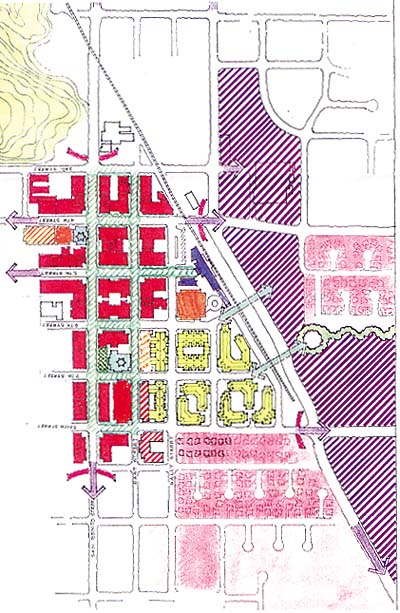
Though downtown Hollister is enduring the rut of a slumping
economy, the Hollister Downtown Association has mapped an
optimistic vision for the city’s future.
HDA members received a colorful copy of the plan,
”
A Vision for Downtown,
”
at a breakfast meeting last week. In September the HDA presented
its ideas to the City Council, and since then the group has worked
to promote the layout designed to increase consumer activity and,
ultimately, the prosperity of downtown businesses.
”
The key to a successful downtown is foot traffic,
”
HDA President Ignacio Velazquez said.
Though downtown Hollister is enduring the rut of a slumping economy, the Hollister Downtown Association has mapped an optimistic vision for the city’s future.
HDA members received a colorful copy of the plan, “A Vision for Downtown,” at a breakfast meeting last week. In September the HDA presented its ideas to the City Council, and since then the group has worked to promote the layout designed to increase consumer activity and, ultimately, the prosperity of downtown businesses.
“The key to a successful downtown is foot traffic,” HDA President Ignacio Velazquez said.
The map was designed by Behr and Browers Architects. Francisco Behr of the San Luis Obispo-based firm said the plan is “by no means a static blueprint.” Rather, it’s a vision with basic ideas, he said.
Some of those ideas include increased residential space, targeted “key businesses” such as food and entertainment, and an overall improved image.
“This is about providing convenient parking, attractive and generous sidewalks, nice landscaping and unifying street graphics and furniture,” Behr said.
Hollister’s Community Development Department is also beginning the process of creating a new General Plan – the entire city’s “blueprint” for the future. The plan was last updated in 1995.
The update will include a “downtown strategy,” according to Bill Avera, director of the Hollister Redevelopment Agency. Avera said the HDA will have the opportunity to lobby its ideas during a 10- to 12-month period for public participation.
In recent years, the HDA has often reacted too passively to the changing local economic landscape, Velazquez said.
“We knew we needed to put together a downtown rather than letting it sit year after year and watch it keep falling,” he said.
A major problem right now, for instance, is empty space as an unusually high number of vacancies have cropped up downtown. The HDA prefers increasing commercial density in the “heart of downtown,” according to Velazquez, rather than businesses “sprawling” out elsewhere in Hollister.
Several prominent sites remain unoccupied downtown, including the historic building at Fifth and San Benito Streets formerly home to Union Bank, which moved in October to a location in the Nob Hill shopping center on Airline Highway.
“A Vision for Downtown Hollister” identifies the 400 block of San Benito Street and its development as the key to progress.
HDA officials have expressed optimism about the possibility of a 10- or 12-screen movie theater on the open space east of the Briggs Building at Fourth and San Benito streets. Velazquez estimated such a project could potentially draw 100,000 people per year.
“It’s a chance for small business owners to survive,” he said, adding that other cities such as Santa Cruz have experienced widespread success with a centrally located theater.
“The 400 block is very important. There are different types of uses there,” Avera said.
Several Hollister residents at the Sept. 9 City Council meeting also expressed their views about the open space on the corner of Fourth and San Benito streets.
Michael Klingensmith argued that a park would allow recreational opportunities for families downtown. Charles Scott wanted San Benito Street to become a two-lane street with more trees. And Ted Intravia argued against the HDA’s theater idea, saying the downtown area cannot support a multi-plex theater and its potential parking problems.
The HDA is still discussing several possibilities to complete its plan, including the theater. Members of the group have expressed confidence that support will be there when the appropriate time comes.
“Most Council members like the plan,” Velazquez said. “In general, most people we’ve shown believe it’s a good plan.”
Avera said he also hopes aspects of the HDA’s vision become reality. But first, the city must analyze the “economic feasibility” of such projects before breaking ground on anything.
“Something like that (the HDA plan) would be everybody’s dream of a downtown,” Avera said.









